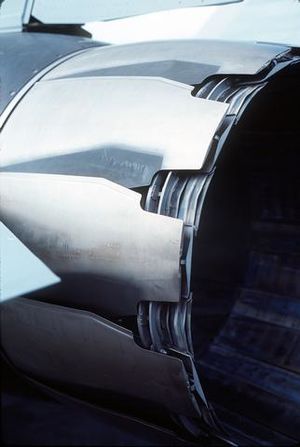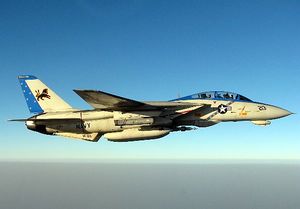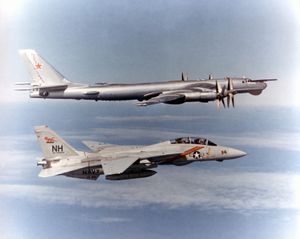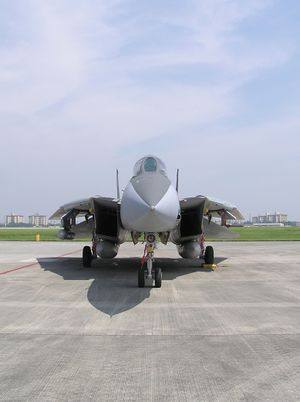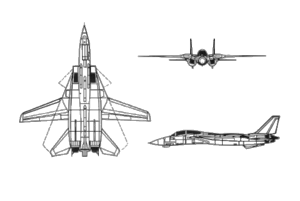PlaneSpottingWorld welcomes all new members! Please gives your ideas at the Terminal.
F-14 Tomcat
| F-14 Tomcat | |
|---|---|
| An F-14A Tomcat from the USS Nimitz during Operation Southern Watch | |
| Type | Interceptor/multi-role Fighter aircraft |
| Manufacturer | Grumman |
| Designed by | Bob Kress, engineering manager[1] |
| Maiden flight | 21 December 1970 |
| Retired | 22 September 2006, USN |
| Status | Active service with Iran Retired from US service |
| Primary users | United States Navy Islamic Republic of Iran Air Force |
| Number built | 712 |
| Unit cost | US$38 million in 1998 |
The Grumman F-14 Tomcat is a supersonic, twin-engine, two-seat, variable geometry wing aircraft. The F-14 was the United States Navy's primary maritime air superiority fighter, fleet defense interceptor and tactical reconnaissance platform from 1974 to 2006. It later performed precision strike missions once it was integrated with LANTIRN.[2] It was developed after the collapse of the F-111B project, and was the first of the American teen-series fighters which were designed incorporating the experience of air combat in Vietnam against MiGs.
It entered service in 1972 with the U.S. Navy, replacing the F-4 Phantom II. It was later exported to the Imperial Iranian Air Force in 1976. It was retired from the U.S. Navy fleet on 22 September 2006, having been replaced by the F/A-18E/F Super Hornet.[3] As of 2007, it remains in service only with the Islamic Republic of Iran Air Force.
Contents
Development
The F-14 Tomcat program was initiated when it became obvious that the weight and maneuverability issues plaguing the U.S. Navy variant of the Tactical Fighter Experimental (TFX) (F-111B) would not be resolved to the Navy's satisfaction. The Navy requirement was for a fleet air defense fighter (FADF) with the primary role of intercepting Soviet bombers before they could launch missiles against the carrier group. The Navy also wanted the aircraft to possess inherent air superiority characteristics. The Navy strenuously opposed the TFX, which incorporated the Air Force's requirements for a low-level attack aircraft, fearing the compromises would cripple the aircraft, but were forced to participate in the program at direction of then Secretary of Defense Robert McNamara who wanted "joint" solutions to the service aircraft needs to reduce developmental costs. The prior example of the F-4 Phantom which was a Navy program later adopted by the USAF (under similar direction) was the order of the day. Vice Admiral Connolly, DCNO for Air Warfare took the developmental F-111A for a flight and discovered it was unable to go supersonic and had poor landing characteristics. He later testified to Congress about his concerns against the official Department of the Navy position and in May 1968, Congress killed funding for the F-111B allowing the Navy to pursue an answer tailored to their requirements.
NAVAIR shortly issued an RFP for the Naval Fighter Experimental (VFX), a tandem two-seat fighter with maximum speed of Mach 2.2 and a secondary close air support role. Of the five companies that submitted bids (four of which incorporated variable-geometry wings as on the F-111), McDonnell Douglas and Grumman were selected as finalists in December 1968, and Grumman won the contract in January 1969. Grumman had been a partner on the F-111B, and had started work on an alternative when they saw the project heading south, and so had an edge on its competitors. Their early design mock-ups and cost projections were floated among Navy brass as an alternative to the F-111B.[4]
The winning Grumman design reused the TF30 engines from the F-111B, though the Navy planned on replacing them with the F401-PW-400 engines then under development by Pratt and Whitney for the Navy (in parallel with the related F100 for the USAF).[5] Though lighter than the F-111B, it was still the largest and heaviest U.S. fighter to ever fly from an aircraft carrier, its size a consequence of the requirement to carry the large AWG-9 radar and AIM-54 Phoenix missiles, also from the F-111B and an internal fuel load of 16,000 lbs (7300 kg). The F-14 would also share a similar inlet duct, wing, and landing gear geometry with Grumman's A-6 Intruder.[6]
Upon being granted the contract for the F-14, Grumman greatly expanded its Calverton, Long Island, New York facility to test and evaluate the new swing-wing interceptor. Much of the testing was in the air of the Long Island Sound as well as the first few in-flight mishaps, including the first of many compressor stalls and ejections. In order to save time and forestall interference from Secretary McNamara, the Navy skipped the prototype phase and jumped directly to full-scale development; the Air Force took a similar approach with its F-15.[7]
The F-14 first flew on 21 December 1970, just 22 months after Grumman was awarded the contract, and reached Initial Operational Capability (IOC) in 1973. While the Marine Corps was interested in the F-14 and went so far as to send pilots to VF-124 to train as instructors, they were never fully sold on the aircraft and pulled out when the stores management system for ground attack munitions was left undeveloped, leaving the aircraft incapable of dropping air-to-ground munitions (these were later developed in the 1990s).[7]
Further improvements
Firing trials involved the launch against simulated targets of every type, from cruise missiles to high flying bombers. The first Phoenix launch by a Tomcat occurred on 28 April 1972.[8] In November of that year, a single launch was achieved against an incoming target at over 200 km, this being outside the normal range for the Tomcat weapon system of 166 km. Another unusual test was made in 22 November 1973, with six missiles fired in 38 seconds, at Mach 0.78 and 24,800 feet (7600 m), with four scoring direct hits. This missile entered service at the beginning of 1975, just as the Vietnam War was coming to an end.
With time, the early versions of all the missiles were replaced by more advanced versions, especially with the move to full solid-state electronics that allowed better reliability, better ECCM and more space for the rocket engine. So the early arrangement of AIM-54A, AIM-7E-2 ,and AIM-9J was replaced in the 1980s with the B (1983) and C (1986) version of the Phoenix, the F (1977), M (1982), P (1987 or later) for Sparrows, and with the Sidewinder, L (1979) and M (1982). Within these versions there are several improved batches (for example, Phoenix AIM-54C++).[8]
However, it was only recently that the Tomcat performed air-to-surface missions, with the reduction of noticeable threats, such as Tu-22M regiments. The first experiments with bombs were carried out in August 1990. However, the F-14s were kept so busy with the main task of air defense (as were the F-15s) in Operation Desert Storm that the air-to-ground missions were left to A-7 and F/A-18 squadrons.
Design
Overview
The F-14 Tomcat was designed as both an air superiority fighter and a long range, naval interceptor. The F-14 has a two seat cockpit with a canopy that affords 360 degree visibility. The plane features variable geometry wings that swing automatically during flight. For high-speed intercept, they are swept back; they swing forward to allow the F-14 to turn sharply and dogfight. It was designed to improve on the F-4 Phantom's air combat performance in several respects. The F-14's fuselage and wings allow it to climb faster than the F-4, while the twin-tail arrangement offers better stability. During the Vietnam conflict, the F-4's lack of a gun was criticized by fighter pilots, and the belated use of a 20 mm gun pod attached to a hardpoint, while useful, was not an optimal solution. As a result, Grumman equipped the F-14 with an internal 20 mm Vulcan Gatling-type gun mounted on the left side, and can carry Phoenix, Sparrow, and Sidewinder anti-aircraft missiles. The U.S. Navy wanted the F-14 to have a thrust-to-weight ratio of one or greater, though this was not achieved until after the F-14 entered service because of delays in engine development.
Technical description
Fuselage and wings
The fuselage, with the engines fitted below, is capable of generating more auxiliary lift, since it is a "lifting body". The fuselage itself, with the two air intakes and engine nacelles below, is a large fuel tank, and also carries electronics and the wing sweep mechanism.
The F-14's wing sweep can be varied between 20 and 68° in flight,[9] and is automatically controlled by an air data computer. This maintains the wing sweep to give the optimum lift-to-drag ratio as the Mach number varies, but the system can be manually overridden by the pilot if necessary. When the aircraft is parked, the wings can be swept to 75°, where they overlap the tail to save space on tight carrier decks.
The wings have a two-spar structure with integral fuel tanks. Much of the structure, including the wing box, wing pivots and upper and lower wing skins is made of titanium,[8] a light, rigid and strong material, but also difficult to weld, and costly.
Ailerons are not fitted, with roll control being provided by wing mounted spoilers at low speed (which are disabled if the sweep angle exceeds 57°), and by differential operation of the all-moving tailerons at high speed.[8] Full-span slats and flaps are used to increase lift both for landing and combat, with slats being set at 17° for landing and 7° for combat, while flaps are set at 35° for landing and 10° for combat.[8] The twin tail layout helps in maneuvers at high AoA (angle of attack) while reducing the height of the aircraft to fit within the limited roof clearance of hangars aboard aircraft carriers. Two underbelly fixed surfaces are under the engines.
Two retractable surfaces, called glove vanes, were originally mounted in the wing gloves, and could be automatically extended by the flight control system at high Mach numbers. They were used to generate additional lift ahead of the aircraft's center of gravity, thus helping to compensate the nose-down pitching moment of supersonic speeds. Automatically deployed at above Mach 1.4, they allowed the F-14 to pull 7.5 g at Mach 2 and could be manually extended at above Mach 1. They were later disabled, however, owing to their additional weight and complexity.[8]
Two air brakes are fitted under the aft fuselage in a flat section between the engines, sometimes called the "castor tail".[10] Near them is an arrestor hook for carrier landings. The F-14 can land with the wings swept fully aft.[8] The Tomcat has mechanical flying controls,[8] with the only exception being the spoilers, which are electrically driven.
Engines and landing gear
The engines are fed by two rectangular air intakes located under the wings. These engines, P&W JT10A, better known as TF-30, were relatively powerful for the time (5.670/9.480 kg/t) and being turbofans, they allowed reduced fuel consumption while cruising. This was important to give F-14s good endurance in long patrols. Both air intakes and engines exhausts have moving parts to optimize them to the speed and other variables. Despite winning the contract with F-401 engines, these engines left too much to be desired both in power and reliability. John Lehman, Secretary of the Navy, told Congress that the F-14/TF30 combination was "probably the worst engine/airframe mismatch we have had in years" and said that the TF30 was "a terrible engine",[9] [10] with F-14 accidents attributed to engine failures accounting for 28% of overall losses. The cracks in the turbines were dangerous to the point that the engine bay was reinforced in case of explosion (TF-300-401). The overall thrust-to-weight ratio at maximum load is around 0.56 to 1, which does not compare favorably with the F-15A's ratio of 0.85 to 1.[11] Even so, the aircraft itself is able to reach Mach 2.4, and the maximum speed is officially Mach 2.34. Internal fuel capacity is 2,400 US gallons (9100 L)—including 290 US gallons (1100 L) in each wing, 690 US gallons (2600 L) in a tank aft of the cockpit and a further 457 US gallons (1730 L) in two feeder tanks. The aircraft can carry two 269 US gallon (1020 L) external tanks under the air intakes.[citation needed] There is also an air-to-air refueling probe, which folds into the nose.
The undercarriage is very robust, in order to withstand the harsh takeoffs and landings necessary for carrier operation. It comprises a double nose wheel and widely spaced single main wheels. The result is very different from the narrow and high undercarriage of F-15 Eagle. Both have similar weights, and a high wing that makes undercarriage stowage impractical, but the Tomcat fuselage is wider and the aircraft does not need to hold big external fuel tanks, as the Eagle often does, in the ventral positions. There are no hardpoints on the moving-section wings, and so all the armament is fitted underneath, between the air intakes and under the small, fixed part of the wings.
Avionics and flight controls
The cockpit has two seats, arranged in tandem. The pilot and radar intercept officer (RIO) sit in Martin-Baker GRU-7A rocket-propelled ejection seats, rated from zero altitude and zero airspeed up to 450 knots.[12] They have a 360° view in a canopy that is also fitted with four mirrors, one for the RIO and the others for the pilot. The canopy is still fairly traditional; being in three parts, but the overall structure is large and gives good visibility. The crews have classical controls and many older instruments, with an analog-digital hybrid lay out. Only the pilot has flight controls.[8] No dual control version was ever made for the F-14, so the pilot starts to learn how to fly the machine using other aircraft and simulators. The main control systems are a HUD made by Kaiser, a VSI and a HSI display, that gives data on airspeed, navigation and other information. The F-14A and F-14B Tomcat do not have multi-mode displays, unlike the later F-16s and F/A-18s.
The nose of the aircraft is large, because it carries not only the two person crew, but also a large number of avionics systems. The combination of the radar and the Phoenix air-air missile is still unmatched. The ECM and navigation suite are extremely comprehensive and complex.
The main element is the Hughes AWG-9 X-band radar, which in the initial version included a lightweight 5400B digital system with 32 kilobytes of RAM and tremendous capability. The antenna is 36 inches (91 cm) wide, uses 10 kW of power and has integrated IFF antennas. There are available several modes, such as Track-While-Scan (TWS), Range-While-Search (RWS), Pulse-Doppler Single-Target Track (PDSTT), Jam Angle Track (JAT). A maximum of 24 targets can be tracked simultaneously and six can be engaged in the mode "multiple"(TWS) up to around 60 miles (100 km). There is also a "single target" mode with a maximum range of around 96 statute miles (150 km). The maximum search range can exceed 120 statute miles (190 km) and even a fighter can be locked onto at around 72 - 90 statute miles (120–140 km). Cruise missiles are also possible targets with the AWG-9, since this radar can lock onto and track even small objects at low altitude with a Doppler filter. The radar is in the nose and weighs around 1300 pounds (590 kg), while behind it is an electronics section and there is a further avionics bay behind the second cockpit. As secondary systems, there are, in the early Tomcats, ECM and RWR systems, chaff launchers, HUD, data link and data link jammers and a precise inertial navigation system.
The original set of sensors also comprised an infrared sensor under the nose: it was AN/ALR-23 with indium antimonide detectors, cooled by a self-contained Stirling-cycle cryogenic system, but this proved ineffective, and was replaced with a new system. This was an optical system, Northrop AAX-1, also called TCS (TV Camera Set) and is used to help pilots visually identify aircraft, at least on day missions,[8] up to a range of more than 60 miles for large aircraft. The zoom function also helps with small fighters and there is even an auto-tracker to ease the task. Both the crew have access to the images on their displays. Despite its utility, for a long time most F-14s did not have the system added. Bill Gunston reported that even in 1983 this lack meant that only one in eight aircraft had the system fitted.[13] In every case, this system is the only one of its kind fielded by modern US fighters for air to air missions.
Later a more complex system was adopted, a dual IR/TCS system. Often the latest Tomcats have it, with an ECM antenna fitted as well in the same mast. This meant Tomcats had either only an ECM antenna, or the IR sensor or TCS or many combinations of them. The Tomcat's ESM system is is made of many subsystems: RWR, ECM, dispensers in various parts of the fuselage, nose, tail and wings. This was a marked difference with many previous fighter aircraft that did not even a simple RWR as standard.
Armament
The Tomcat was needed to face both highly maneuverable aircraft and the cruise missile/bomber threat from Soviet regiments and surface units. All this gave new capabilities to act effectively in every aspect of air combat. For weaponry, the Tomcat was mainly designed as a platform for the formidable AIM-54 Phoenix, but unlike the stillborn F-111B it also had capabilities against medium and short range threats, being a full air superiority fighter and not only a long range interceptor. It had the standard US gun, the M61 Vulcan, with 676 rounds and 4,000 or 6,000 RPM selectable (the latter usually for air-to ground missions). Over 6,700 kg of stores could be carried for combat missions in several hard points under the belly and the wing gloves. Generally, this meant 2 or 4 Phoenix with two AIM-7 sparrow and two AIM-9 Sidewinder air-air missiles, and sometimes also two external fuel tanks. The theoretical maximum load of six Phoenix was so heavy that such a combination was never used operationally, even if it had been possible. This means the capability to engage six targets remained theoretical. Sometimes four AIM-7 and four AIM-9 were carried, as the F-4 and F-15 typically used.
Upgrades
Because the new engine intended for the Tomcat was not yet ready when the plane entered service, the F-14 was fitted with the TF30 turbofan engines used by the F-111. This engine, the first turbofan to be fitted with an afterburner, was designed for use with attack or strike aircraft, not dogfighters. Further, the TF30 only gave the F-14 a 0.75 thrust to weight ratio, about the same as the F-4, though the F-14 still maneuvered better than its predecessor.
F-14B
The F-14 received its first of many major upgrades in March 1987, with the introduction of the F-14A+. Although various systems were upgraded, the biggest improvement of all was the replacement of the TF30 engines with the General Electric F110-400. Along with the long -overdue engines, the F-14A+ also included the state-of-the-art ALR-67 Radar Homing and Warning (RHAW) system, bringing the Tomcat up to date with latest threats. All F-14A+ were redesignated F-14B on 1 May, 1991. The Tomcat had suffered throughout its fleet service with the TF30, which had been planned to be only an interim solution until the more powerful P&W F401 engines were available. The TF30 had been plagued from the start with susceptibility to compressor stalls at high AoA and during rapid throttle transients during ACM or above 30,000 feet, giving rise to comment that pilots had to "fly the engines" and not the aircraft. (Such a compressor stall was a key factor in the death of Lt. Kara Hultgreen in 1994.)
Even more importantly, the F110 engine provided a significant increase in thrust over the 20,900 lbf (93 kN) thrust TF30 with 27,600 lbf (123 kN) of thrust in afterburner giving the Tomcat better than a 1:1 thrust-to-weight at low fuel quantities. The basic engine thrust without afterburner was powerful enough to no longer require afterburner for carrier launches, further increasing the safety margin. The principal benefit was in tactical applications, where the Tomcat could now cruise comfortably above 30,000 ft, which increased its range and survivability. Tomcat aircrews also found the Tomcat to be more competitive in the Air Combat Maneuvering arena. The F-14A+ arrived in time to participate in Desert Storm with VF-74 and VF-103. The F-14 production line switched to producing the F-14B, and 38 were delivered as new production models, while a further 48 were created by conversion from F-14A models.
F-14D
Meanwhile, a more significant upgrade program was initiated to incorporate new digital avionics and weapon system improvements to strengthen its multi-mission competitive edge, resulting in the definitive F-14D version. The F-14D variant was first delivered in 1991 and was a major upgrade with General Electric F110-400 engines like the F-14B, a new Hughes AN/APG-71 radar system, Airborne Self Protection Jammer (ASPJ), Joint Tactical Information Display System (JTIDS), SJU-17(V) Naval Aircrew Common Ejection Seats (NACES) and Infrared Search and Track (IRST). Although the F-14D was to be the definitive version of the Tomcat, the requirement to equip all fleet units with the D model was never realized after the new Secretary of Defense, Dick Cheney, canceled it after 55 aircraft were funded, because of a disagreement with Congress. Thirty-seven of the D models were new production, while another 18 were conversions from F-14A models, leaving the fleet equipped with a variety of F-14A, -B, and -D model Tomcats. The F-14B model Tomcats were further modified with the an improved Programmable Tactical Information Display (PTID) and digital-weapon-system modifications under the F-14B Upgrade program. All Tomcats benefited from the Digital Flight Control System (DFCS) Foreign Cooperative Test (FCT) that demonstrated that an existing GEC Marconi DFCS could be incorporated into the Tomcat, thereby improving handling qualities behind the aircraft carrier, at high AoA, and in ACM situations. The Tomcat had long suffered from out-of-control flight problems, and DFCS provided a major improvement in flight handling characteristics.
Transformation
In late 1994, an initiative was begun that transformed the Tomcat and ushered in its last and most significant operational contribution. In the wake of cancellation of the $1.6B Block 1 Strike upgrade program, an industry team proposed an unorthodox, but potentially viable and, more importantly, rapid integration of the USAF LANTIRN targeting pod onto the Tomcat. Martin Marietta approached the Navy and offered to fund a feasibility demo on a fleet F-14B Tomcat. Permission was received in October 1994 and by March of 1995, a fleet VF-103 F-14B (nicknamed "FLIRCAT") convincingly demonstrated that the Tomcat could indeed drop Laser Guided Bombs (LGB) guided by the LANTIRN pod. The Navy quickly adopted the LANTIRN initiative and began to equip all F-14 variants with precision strike capability using the LANTIRN targeting system, beginning with VF-103's deployment in June 1996. The Tomcat was also upgraded with night vision device (NVD) compatibility, and improved defensive countermeasures through the LAU-138 BOL Chaff-dispensing launch rail, which replaced the LAU-7 Sidewinder launch rail, retaining the ability to launch the AIM-9 and adding a significant increase in Chaff expendable stores. Even at the end of its life, the F-14 Tomcat continued to be upgraded. However, the transformation of the community into a viable strike entity was not only based on hardware upgrades, it also was transformed by the adoption of the Forward Air Controller Airborne (FAC (A)) mission thanks to enterprising and forward-thinking junior officers, who devoted themselves to establishing a curriculum within the Tomcat community.
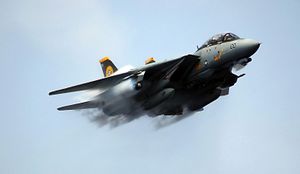
The community also benefited from the retirement of the A-6 Intruder, which brought the best of those air crews into the Tomcat Ready Rooms providing an invaluable corporate memory of precision-strike knowledge. At stake was whether the two-seat cockpit was still needed after the advent of better on-board computers to assist single-seat pilots. After LANTRIN-equipped Tomcats demonstrated time after time that hard targets were best served by two-seat air crews and that FAC (A) was a necessity over the skies of Kosovo, Afghanistan, and Iraq, the decision was made to field a two-seat F/A-18F Super Hornet squadron per air wing, mute testimony to the prowess of the Tomcat in the precision-strike role. The Tomcat further took the LANTIRN Targeting System (LTS) to new capability by adding capability to transmit and receive digital imagery (Fast Tactical Imagery or FTI) and also added precision-strike coordinate generation through software upgrades, to the LANTRIN pod (Tomcat Tactical Targeting) allowing GPS target quality target coordination. The LANTIRN pod was also upgraded with so called 40 K lasers allowing operation above restriction of the original 25 K laser, which had inhibited operations over Kosovo and Afghanistan, as well as restricting launch of weapons such as the GBU-24 at the maximum extent of its envelope. Tomcats also added the ability to carry the GBU-38 Joint Direct Attack Munition (JDAM), giving it the option of a variety of LGB and GPS-guided weapons.
The latest upgrade to the Tomcat included the Link 16 software which enables the aircraft to target enemyaircraft spotted by airborn AWACS aircraft without using its own radar, giving it superior look down kill ability in BVR combat scenarios.[citation needed]
Operational history
- See also: Combat history of the F-14
The F-14 Tomcat was the Navy's primary air superiority fighter and tactical reconnaissance platform from 1972 to 2006. The F-14 served in Iran's Air Force from 1978 to the present day. Knowledge about its use by Iran is limited.
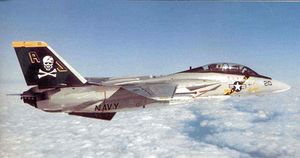
The F-14 began replacing the F-4 Phantom II in USN service starting in September 1974 with squadrons VF-1 Wolfpack and VF-2 Bounty Hunters aboard USS Enterprise and participated in the American withdrawal of Saigon. The F-14 had its first kills on 19 August 1981 over the Gulf of Sidra in what is known as the Gulf of Sidra incident after two F-14s from VF-41 Black Aces were engaged by two Libyan Su-22 "Fitters". The F-14s evaded the short range heat seeking AA-2 "Atoll" missile and returned fire, downing both Libyan aircraft. U.S. Navy F-14s once again were pitted against Libyan aircraft on 4 January 1989, when two F-14s from VF-32 shot down two Libyan MiG-23 "Floggers" over the Gulf of Sidra in a second Gulf of Sidra incident.
Despite the attention given to the Tomcat over aerial encounters in the Gulf of Sidra, its first sustained combat baptism of fire was as a Photo Reconnaissance platform. The Tomcat was selected to inherit the Reconnaissance mission upon departure of the dedicated RA-5C Vigilante and RF-8G Crusaders from the fleet. A large pod called the Tactical Airborne Reconnaissance Pod System or TARPS was developed to house three sensors: a two position 6 in (15 cm) KS-87 frame camera in the forward bay capable of forward oblique or vertical shots selectable by the Radar Intercept Officer, a 9 in (23 cm) KA-99 panoramic camera capable of narrow or wide field of view in the center bay and an AAD-5 InfraRed line scanner in the aft bay. All camera settings were selected by the RIO although the pilot could initiate camera operation if set up to do so in proper position by the RIO. TARPS entered fleet service by 1979 with VF-84 and was intended to be an interim system until a dedicated F/A-18R variant was fully developed. One of each two Tomcat squadrons per airwing was designated as a TARPS unit and received 3 TARPS capable aircraft and training for 4 TARPS aircrews. The TARPS pod was carried on the starboard aft side of the belly stations with ballast (AIM-54 Phoenix pallets or inert Sparrow missiles) in the forward missile stations.
While the Tomcat was being used in combat in its intended air superiority mission over the skies of Iran in the early 1980s, the US Navy found itself flying regular daily combat missions over Lebanon to photograph activity in the Bekaa Valley. At the time, the Tomcat had been thought too large and vulnerable to be used overland, but the need for imagery was so great that Tomcat aircrews developed high speed medium altitude tactics to deal with considerable AAA and SA-7 SAM threat in the Bekaa area. An urgent combat need was stated to address the Tomcat vulnerability in this type of mission. The first exposure of a Tomcat to a SA-2 was over Somalia in April 1983 when a local battery was unaware of two Tomcats scheduled for a TARPS missions in prelude to an upcoming international exercise in vicinity of Berbera. An SA-2 was fired at the second Tomcat while conducting 10 thousand foot mapping profile at max conserve setting. The Tomcat aircrews spotted the missile launch and dove for the deck thereby evading it without damage. The unexpected demand for combat TARPS laid the way for high altitude sensors such as the KA-93 36 in (91 cm) Long Range Optics (LOROP) to be rapidly procured for the Tomcat as well as an Expanded Chaff Adapter (ECA) to be incorporated in a AIM-54 Phoenix Rail. Commercial "Fuzz buster" type radar detectors were also procured and mounted in pairs in the forward cockpit as a stop gap solution to detect SAM radars such as the SA-6. The ultimate solution was upgrade to the ALR-67 then being developed, but it would not be ready until the advent of the F-14A+ in the latter 1980s. During the Gulf of Sidra operations in 1986, the Tomcats were used in over water missions only due to their vulnerability overland. It was not until Desert Shield that US Navy Tomcats were introduced to overland combat operations on a regular basis.
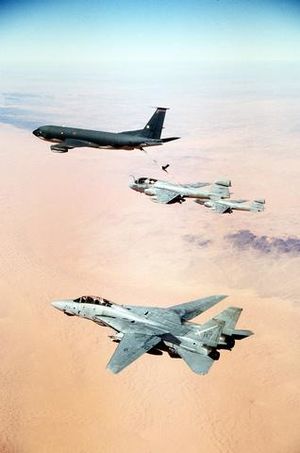
The participation of the F-14 Tomcat in the 1991 Operation Desert Storm consisted of Combat Air Patrol (CAP) over the Red Sea and Persian Gulf and overland missions consisting of strike escort and reconnaissance. Until the waning days of Desert Storm, in country air superiority was tasked to USAF F-15 Eagles due to the way the Air Tasking Orders (ATO) delegated primary overland CAP stations to the F-15 Eagle. The governing Rules of Engagement (ROE) also dictated a strict Identification Friend or Foe (IFF) requirement when employing Beyond Visual Range weapons such as the AIM-7 Sparrow and particularly the AIM-54 Phoenix. This hampered the Tomcat from using its most powerful weapon. Furthermore, the powerful emissions from the AWG-9 are detectable at great range with a radar warning receiver. Iraqi fighters routinely displayed countertactics as soon as the Tomcats "lit up" them with the AWG-9. The Iraqis would immediately abandon the attack while well out of range, perhaps indicating their familiarity with both the Tomcat and the AIM-54 from previous encounters with Iranian F-14s.[citation needed] The US Navy suffered its only F-14 loss from enemy action on 21 January 1991 when b/n 161430, an F-14A upgraded to an F-14A+, from VF-103 was shot down by an SA-2 surface-to-air missile while on an escort mission near Al Asad airbase in Iraq. Both crew survived ejection with the pilot being rescued by USAF Special Forces and the RIO being captured by and held by Iraqi troops as a POW until the end of the war.[14] The F-14 also achieved its final kill, an Mi-8 "Hip" helicopter, with an AIM-9 Sidewinder.
In 1995, F-14s from VF-14 and VF-41 participated in Operation Deliberate Force as well as Operation Allied Force in 1999, and in 1998, VF-32 and VF-213 participated in Operation Desert Fox. On 15 February 2001 the Joint Direct Attack Munition or JDAM was added to the Tomcat's arsenal. On 7 October 2001 F-14s would lead some of the first strikes into Afghanistan marking the start of Operation Enduring Freedom and the first F-14 drop of a JDAM occurred on 11 March 2002. F-14s from VF-2, VF-31, VF-32, VF-154, and VF-213 would also participate in Operation Iraqi Freedom. The F-14Ds of VF-2, VF-31, and VF-213 obtained JDAM capability in March of 2003.[15] On 10 December 2005, the F-14Ds of VF-31 and VF-213 were upgraded with a ROVER III downlink, a system originally designed for use with unmanned aerial vehicles which allows a Forward Air Controller (FAC) on the ground to see real-time images acquired by the aircraft's sensors by transmitting these images to the FAC's laptop.[16] The F-14s of VF-31 and VF-213 deployed on its last combat cruise on USS Theodore Roosevelt in 2005.
Replacement of the F-14
While the F-14 had been developed as a light weight alternative to the 80,000 lb (36,000 kg) F-111B, the F-14 was still the largest and most expensive fighter in its time. VFAX was revived in the 1970s as a lower cost solution to replacing the Navy's fleet of USMC Phantoms, and A-7. VFAX would be merged with the USAF Light Weight Fighter fighter competition, from which the F/A-18 Hornet emerged as roughly a midsize fighter.
In 1994, Congress would reject Grumman proposals to the Navy to upgrade the Tomcat beyond the D model (such as the Super Tomcat 21, the cheaper QuickStrike version, and the more advanced Attack Super Tomcat 21).[17] Instead, the Navy elected to retire the F-14 and chose the F/A-18E/F to fill the roles of fleet defense and strike formerly filled by the F-14.
Retirement
The F-14 has completed its retirement from US Naval service. At one point, it was slated to remain in service through at least 2008, but all F-14A and F-14B airframes had already been retired, and the last two squadrons, the VF-31 Tomcatters and the VF-213 Black Lions, both flying the "D" models, arrived for their last fly-in at Naval Air Station Oceana on 10 March 2006.[18]
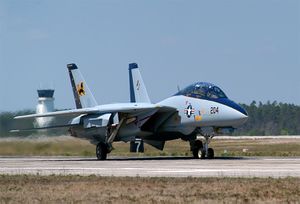
The last American F-14 combat mission was completed on 8 February 2006, when a pair of Tomcats landed aboard the USS Theodore Roosevelt after one dropped a bomb in Iraq. That aircraft was assigned to VF-31 and the aircrew credited with the last bomb dropped in combat by a Navy Tomcat was pilot Lt Justin Halligan and RIO Lt Bill Frank. The other Tomcat on that mission was an F-14D from VF-213 piloted by Commander Air Wing Eight, Capt. William G. Sizemore, and became the last F-14 to land on an aircraft carrier after a combat mission. During their final deployment with the USS Theodore Roosevelt, VF-31 and VF-213 collectively completed 1,163 combat sorties totaling 6,876 flight hours, and dropped 9,500 pounds (4300 kg) of ordnance during reconnaissance, surveillance, and close air support missions in support of Operation Iraqi Freedom.[19]
On 10 March 2006, the 22 planes from these squadrons flew in formation into Naval Air Station Oceana after the last deployment of the F-14. VF-31 remained operational in the F-14 Tomcat under the Fleet Response Plan (FRP) through September and conducted the last carrier qualifications in late July maintaining their ability to deploy right up until the end. VF-213 and VF-31 would transition to the Super Hornet training.
The USS Theodore Roosevelt (CVN-71) shot from its catapult an F-14D, assigned to VF-31, for the last time on 28 July 2006. It was piloted by Lt Blake Coleman & RIO Lt Cmdr Dave Lauderbaugh.[20] The last trap recovery was made a while before by Lt Chris Rattigan and Lt Paul Dort, on aircraft no.110. The "official" final flight retirement ceremony was on 22 September 2006 at Naval Air Station Oceana. The ceremonial last flight was flown by Lt Cmdr Chris Richard & RIO Lt Mike Petronis in a backup F-14,[21] after the primary aircraft experienced a mechanical problem.[22] The actual last flight of the F-14 Tomcat in US service took place 4 October 2006, when an F-14D of VF-31 was ferried from Oceana to Republic Airport on Long Island, NY.[21]
The remaining intact US Navy F-14 aircraft have been stored at the "Boneyard" of Davis-Monthan Air Force Base, Arizona. As of July 2007, the remaining 165 aircraft were being shredded to prevent parts from being acquired by hostile states. By July 2007, 23 F-14s had been shredded by a 120,000 lb machine at a cost of $900,000. Because of the strength of the landing gear, it was removed before shredding and cut up with a torch.[23]
Iran
The sole foreign customer for the Tomcat was the Imperial Iranian Air Force, during the reign of the last Shah (King) of Iran, Mohammad Reza Pahlavi.
In the early 1970s, the Imperial Iranian Air Force (IIAF) was searching for an advanced fighter, specifically one capable of intercepting Soviet MiG-25 "Foxbat" reconnaissance flights. After a visit of U.S. President Richard Nixon to Iran in 1972, during which Iran was offered the latest in American military technology, the IIAF narrowed its choice to the F-14 Tomcat or McDonnell Douglas F-15 Eagle. Grumman Corporation arranged a competitive demonstration of the Eagle against the Tomcat before the Shah, and in January 1974 Iran ordered 30 F-14s and 424 AIM-54 Phoenix missiles, initiating Project Persian King, worth US$300 million. Only a few months later, this was expanded by an order for 50 additional F-14As and 290 AIM-54s. The Iranian order was for 80 Tomcats and 714 Phoenix missiles, spare parts, and replacement engines for ten years, complete armament package, and support infrastructure (including construction of the huge Khatami Air Base in the desert near Esfahan).
The first F-14 arrived in January 1976, modified only by the removal of classified avionics components, but fitted with the TF-30-414 engines. The following year 12 more were delivered. Meanwhile, training of the first groups of Iranian crews by the US Navy, was underway in the USA; and one of these conducted a successful shoot-down of a target drone flying at 50,000 ft (15 km), with a Phoenix missile.
Following the overthrow of the Shah in 1979, the air force was re-named the Islamic Republic of Iran Air Force (IRIAF) and the regime of Ayatollah Khomeini canceled most Western arms orders. Large shipments of spares were held back, including the last Tomcat built for Iran, which was embargoed and eventually turned over to the United States Navy. Deteriorating relations led to an arms embargo being imposed on Iran, which included parts for its western fighters and missiles. The IRIAF was able to obtain limited amounts of spare parts and weapons for its American-made aircraft during the Iran-Contra Affair. Deliveries came via Israel and later, from the USA.
In January 2007, it was announced by the US Department of Defense that sales of spare parts for F-14s would be suspended, due to concerns that they could end up in Iran. It announced that the decision was taken "given the current situation in Iran".[24] On 2 July 2007, the remaining American F-14s were being shredded to ensure that F-14 spare parts would not be acquired by governments considered hostile to the US.[23]
Variants
A total of 712[25] F-14s were built at Grumman's factory in Calverton on Long Island from 1969 to 1991.[26] While the F-14 is listed as being produced in Bethpage, NY, all construction and test flights were performed out of Grumman's Calverton facility. The Bethpage facility was home to the engineers who designed the F-14 and it produced World War II aircraft. But Bethpage no longer had the facilities or airport required to produce such a large airplane.[26] Over 160 of the US aircraft were destroyed in accidents.[27]
- YF-14A: Prototypes and pre-production aircraft, 12 built.
- F-14A: The original production two-seat all-weather interceptor fighter version for the US Navy. Modifications late in its service life added precision strike munitions to its armament. 545 F-14A aircraft were delivered to the US Navy and 79 to Iran. The final 102 F-14As were delivered with improved TF30-P-414A engines.[28] Additionally, an 80th F-14A was manufactured for Iran, but was delivered to the US Navy.
- F-14A Plus or F-14B: Upgraded version of the F-14A with GE F110-400 engines. Much of the avionics as well as the AWG-9 radar were retained. Later re-designated F-14B. Thirty eight new aircraft were manufactured and 48 F-14A were upgraded to B variants.[29] In the late 1990s, 67 F-14Bs were upgraded to extend airframe life and improve offensive and defensive avionics systems. The modified aircraft became known as F-14B Upgrade aircraft.[28]
- F-14D Super Tomcat: The final incarnation of the F-14. The original TF-30 engines were replaced with GE F110-400 engines, similar to the F-14B. The F-14D also included newer digital avionics systems including a Glass cockpit and replaced the AWG-9 with the newer APG-71 radar. A total of 37 new aircraft were constructed and 18 F-14A were upgraded to D variants.[29]
Operators
- United States Navy (USN) squadrons
- Pacific Fleet
- NFWS Navy Fighter Weapons School (Top Gun) (Merged with (NSAWC) 1996))
- VF-1 Wolfpack (Disestablished 30 September 1993)
- VF-2 Bounty Hunters (Redesignated VFA-2 with F/A-18F 1 July 2003)
- VF-21 Freelancers (Disestablished 31 January 1996)
- VF-24 Fighting Renegades (Disestablished 20 August 1996)
- VF-51 Screaming Eagles (Disestablished 31 March 1995)
- VF-111 Sundowners (Disestablished 31 March 1995)
- VF-114 Aardvarks (Disestablished 30 April 1993)
- VF-124 Gunfighters (Disestablished 30 September 1994)
- VF-154 Black Knights (Redesignated VFA-154 with F/A-18F 1 October 2003)
- VF-191 Satan's Kittens (Disestablished 30 April 1988)
- VF-194 Red Lightnings (Disestablished 30 April 1988)
- VF-201 Hunters (Redesignated VFA-201 with F/A-18A 1 January 1999)
- VF-202 Superheats (Disestablished 31 December 1999)
- VF-301 Devil's Disciples (Disestablished 11 September 1994)
- VF-302 Stallions (Disestablished 11 September 1994)
- Atlantic Fleet
- VF-11 Red Rippers (Redesignated to VFA-11 with F/A-18F in May, 2005)
- VF-14 Tophatters (Redesignated VFA-14 with F/A-18E 1 December 2001)
- VF-31 Tomcatters (Redesignated VFA-31 with F/A-18E October, 2006)
- VF-32 Swordsmen (Redesignated VFA-32 with F/A-18F on 1 October 2005)
- VF-33 Starfighters (Disestablished 1 October 1993)
- VF-41 Black Aces (Redesignated VFA-41 with F/A-18F, 1 December 2001)
- VF-74 Bedevilers (Disestablished 30 April 1994)
- VF-84 Jolly Rogers (Disestablished 1 October 1995)
- VF-101 Grim Reapers (Disestablished 15 September 2005)
- VF-102 Diamondbacks (Redesignated VFA-102 with F/A-18F in 1 May 2002)
- VF-103 Sluggers/Jolly Rogers (Redesignated VFA-103 with F/A-18F 1 May 2005)
- VF-142 Ghostriders (Disestablished 30 April 1995)
- VF-143 Pukin' Dogs (Redesignated VFA-143 with F/A-18E in early 2005)
- VF-211 Fighting Checkmates (Redesignated VFA-211 with F/A-18F 1 October 2004)
- VF-213 Black Lions (Redesignated VFA-213 with F/A-18F in May 2006)
- Test and Evaluation Squadrons
- Islamic Republic of Iran Air Force (IRIAF) squadrons
- 72nd TFS: F-14A, 1976 - 1980
- 73rd TFS: F-14A, 1977 - until mid-1990s
- 81st TFS: F-14A, 1977 - until today
- 82nd TFS: F-14A, 1978 - until today
- 83rd TFS: F-14A, re-named former 73rd TFS[30]
Survivors
F-14s preserved at museums include:
- Number Model - Location. Significance
- (R): Signifies an F-14B or D manufactured from an F-14A.
- 157982 YF-14A - Cradle of Aviation Museum, Garden City, NY. Prototype #3 Nonstructural Demonstration Testbed
- 157984 YF-14A - National Museum of Naval Aviation, Pensacola, FL. Prototype #5 Systems Compatibility Demonstrator/Testbed
- 157986 YF-14A/B - Intrepid Sea-Air-Space Museum, New York City, NY. Prototype #7 Engine/F-14B Testbed
- 157990 YF-14A - The March Field Air Museum, Riverside, CA. Prototype #11 Avionics Testbed
- 158978 F-14A - San Diego Aircraft Carrier Museum on board the USS Midway, San Diego, CA
- 159432 F-14A - Cradle of Aviation Museum, Garden City, NY. Forward Fuselage preserved
- 159610 F-14D(R) - Steven F. Udvar-Hazy Center, Dulles, VA. One of the F-14s involved in the second Gulf of Sidra incident.
- 159624 F-14A - Wings Over the Rockies Air Museum, Denver, Colorado
- 160382 F-14A - Museum of Flight, Seattle, WA
- 160395 F-14A - Kalamazoo Aviation History Museum, Kalamazoo, MI
- 160666 F-14A - Western Aerospace Museum, Oakland, CA
- 160684 F-14A - Pima Air & Space Museum, Tucson, AZ
- 160889 F-14A - Pacific Coast Air Museum, Santa Rosa, CA
- 160899 F-14A - Cradle of Aviation Museum, Garden City, NY
- 160902 F-14A - Grumman Memorial Park, Calverton, NY
- 161163 F-14D(R) - Prairie Aviation Museum, Bloomington, IL
- 161166 F-14D(R) - Carolinas Aviation Museum, Charlotte, NC. VF-213, Last F-14 to launch on a combat mission (Iraq February 2006)
- 161422 F-14B(R) - Naval Air Station Wildwood Aviation Museum, Cape May, NJ
- 161426 F-14D(R) - DeLand Naval Air Station Museum, DeLand, FL
- 161134 F-14A - Valiant Air Command, Titusville FL. Has squadron VF-41, "Black Aces" markings
- 161598 F-14A - Tulsa Air and Space Museum, Tulsa, OK. Has squadron VF-41, "Black Aces" markings
- 161605 F-14A - Wings Of Eagles Discovery Center/National Warplane Museum, Horseheads, NY
- 161625 F-14A - Patuxent River Naval Air Museum, Lexington Park, MD.
- 162689 F-14A - USS Hornet Museum, Alameda, CA, VF-101 "Grim Reapers", retired August 31, 2000
- 162912 F-14B - Grissom Air Museum, Peru IN. First aircraft retired from VF-11 Red Rippers
- 163904 F-14D - Hickory Regional Airport, Hickory, NC. VF-31 Modex 107, Tomcat flown at Sunset Ceremony at NAS Oceana
- 164601 F-14D - Castle Air Museum, Atwater, CA. It was delivered to the Navy 17 April 1992 and was one of the last five built. It also served with VF-31 and was deployed with VF-31 on the USS Abraham Lincoln and saw combat in Afghanistan and Iraq.
- 164603 F-14D - American Air Power Museum, Farmingdale, NY. VF-31 Modex 101 Last (American) Tomcat to take flight
- 164604 F-14D - NAS Oceana, Virginia Beach, VA. Last F-14 built by Grumman.
- (unknown) F-14 - Palm Springs Air Museum, Palm Springs, CA.[4]
- (unknown) F-14A - Aviation Challenge Camp, Huntsville, AL. Has the "Jolly Rogers" Insignia on left tail - Once on 3-day stand-by
- (unknown) F-14A - Mid-America Air Museum, Liberal, Kansas. Stationed on the U.S.S. Theodore Roosevelt
Specifications (F-14D Super Tomcat)
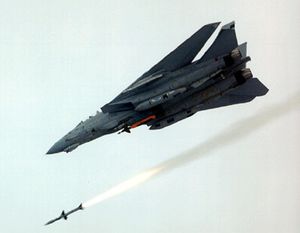
Data from U.S. Navy file [31], [32]
General characteristics
- Crew: 2 (Pilot and Radar Intercept Officer)
- Length: 62 ft 9 in (19.1 m)
- Wingspan:
- Spread: 64 ft (19.5 m)
- Swept: 38 ft (11.58 m)
- Height: 16 ft (4.88 m)
- Wing area: 565 ft² (54.5 m²)
- Airfoil: NACA 64A209.65 mod root, 64A208.91 mod tip
- Empty weight: 43,735 lb (19,838 kg)
- Loaded weight: 61,000 lb (27,700 kg)
- Max takeoff weight: 74,350 lb (33,720 kg)
- Powerplant: 2× General Electric F110-GE-400 afterburning turbofans
- Dry thrust: 13,810 lbf (61.4 kN) each
- Thrust with afterburner: 27,800 lbf (124.7 kN) each
Performance
- Maximum speed: Mach 2.34 (1,544 mph, 2,485 km/h) at high altitude
- Combat radius: 500 nmi (575 mi, 926 km)
- Ferry range: 1,600 nmi (1,840 mi, 2,960 km)
- Rate of climb: >45,000 ft/min (229 m/s)
- Wing loading: 113.4 lb/ft² (553.9 kg/m²)
- Thrust/weight: 0.91
Armament
13,000 lb (5,900 kg) of ordnance including:
- Guns: 1× M61 Vulcan 20 mm Gatling Gun
- Missiles: AIM-54 Phoenix, AIM-7 Sparrow, AIM-9 Sidewinder air-to-air
- Loading configurations:
- 2× AIM-9 + 6× AIM-54
- 2× AIM-9 + 2× AIM-54 + 4× AIM-7
- 2× AIM-9 + 4× AIM-54 + 2× AIM-7
- 2× AIM-9 + 6× AIM-7
- 4× AIM-9 + 4× AIM-54
- 4× AIM-9 + 4× AIM-7
- Bombs: GBU-10, GBU-12, GBU-16, GBU-24, GBU-24E Paveway I/II/III LGB, GBU-31, GBU-38 JDAM, Mk-20 Rockeye II, Mk-82, Mk-83 and Mk-84 series iron bombs
Avionics
Popular culture
The F-14 inspired a number of "pop" cultural uses worldwide. In 1980, the time-travel film The Final Countdown featured the VF-41 "Black Aces" and VF-84 "Jolly Rogers" F-14 fighter squadrons aboard USS Nimitz. In 1986, the F-14 was the main aircraft in the film Top Gun, spawning a video game franchise. The 1995–2005 TV series JAG featured a qualified F-14 pilot as a lead character and a retired F-14 airframe in several episodes. The F-14 has been featured in numerous other video games, and lesser roles in other films and TV series.
References
- Notes
- ↑ Bob Petrella (Writer), Max Raphael (Narrator). (12 March).(2002). Modern Marvels [DVD]. The History Channel.
- ↑ "F-14 Tomcat fighter U.S. Navy Fact File." United States Navy, 5 July 2003. F-14 Tomcat fighter Retrieved: 20 January 2007.
- ↑ Barisic, Sonja. "Navy's Iconic 'Top Gun' jet makes Ceremonial Final Flight, with 1 Hitch." Associated Press, 22 September 2006. [1] Retrieved: 20 January 2007. Read full version here.
- ↑ Woolridge, Capt. E.T., ed. Into the Jet Age: Conflict and Change in Naval Aviation 1945-1975, an Oral History. Annapolis, Maryland: Naval Institute Press, 1995. Note: Admiral Thomas F. Connolly wrote the chapter, "The TFX - One Fighter For All", in Into the Jet Age....
- ↑ Spick 2000, p. 112.
- ↑ Gunston and Spick 1983, p. 112.
- ↑ 7.0 7.1 Jenkins, Dennis R. F/A-18 Hornet: A Navy Success Story. New York: McGraw-Hill, 2000. ISBN 0-07-134696-1.
- ↑ 8.0 8.1 8.2 8.3 8.4 8.5 8.6 8.7 8.8 8.9 Grumman F-14A Tomcat page, Joe Baugher, February 13, 2000.
- ↑ 9.0 9.1 Dorr 1991, p. 50.
- ↑ 10.0 10.1 Sgarlato 1988, p. 40-46.
- ↑ Spick 2000
- ↑ Dorr 1991, p. 51.
- ↑ Gunston and Spick 1983, p. 66.
- ↑ Baugher, Joe. US Navy and US Marine Corps BuNos, 30 September 2006. Retrieved: 7 January 2007.
- ↑ "U.S. Navy's F-14D Tomcats Gain JDAM Capability." Navy Newsstand (United States Navy), 21 March 2003. Retrieved: 20 January 2007.
- ↑ "ROVER System Revolutionizes F-14's Ground Support Capability." Navy Newsstand (United States Navy), 14 December 2005. [2] Retrieved: 20 January 2007.
- ↑ Donald 2004, p. 13, 15.
- ↑ Squadron Homecoming Marks End of Era for Tomcats. US Navy, 10 March 2006 [3] Retrieved: 20 January 2007.
- ↑ Murphy, Stephen. "TR Traps Last Tomcat from Combat Mission". Navy Newsstand, 15 February 2006. Retrieved: 20 January 2007.
- ↑ "Final launch of the F-14 Tomcat"
- ↑ 21.0 21.1 Vanden Brook, Tom. "Navy retires F-14, the Coolest of Cold Warriors". USA Today, 22 September 2006. Retrieved: 20 January 2007.
- ↑ Tiernan, Bill. "F-14's Final Flight." Virginian-Pilot, 23 September 2006.
- ↑ 23.0 23.1 "Pentagon shreds F-14s to keep parts from enemies", AP, 2 July 2007.
- ↑ US halts sale of F-14 jet parts
- ↑ F-14 Bureau Numbers
- ↑ 26.0 26.1 Anft, Torsten. Grumman Memorial Park. Home of M.A.T.S. Retrieved: 28 December 2006.
- ↑ Anft, Torsent. "F-14 Crashes sorted by Date." Home of M.A.T.S. Retrieved: 1 January 2008.
- ↑ 28.0 28.1 F-14 Tomcat variants. GlobalSecurity.org. Retrieved: 20 September 2006.
- ↑ 29.0 29.1 Anft, Torsent. "F-14 Bureau Numbers." Home of M.A.T.S. Retrieved: 30 September 2006.
- ↑ Cooper, Tom and Davey, Chris. Iranian F-14 Tomcat Units in Combat (Osprey Combat Aircraft No. 49). London: Osprey, 2004. ISBN 1-84176-787-5.
- ↑ U.S. Navy file
- ↑ M.A.T.S.
- Bibliography
- Crosby, Francis. Fighter Aircraft. London: Lorenz Books, 2002. ISBN 0-7548-0990-0.
- Donald, David. Warplanes of the Fleet. London: AIRtime Publishing Inc., 2004. ISBN 1-880588-81-1.
- Dorr, Robert F. "F-14 Tomcat: Fleet Defender", World Air Power Journal. Volume 7 Autumn/Winter 1991. p. 42-99. Aerospace Publishing. London. ISSN 0959-7050.
- Drendel, Lou. F-14 Tomcat in Action. Carrollton, Texas: Squadron/Signal Publications, 1977. ISBN 0-89747-031-1.
- Eden, Paul. Modern Military Aircraft. Phoenix, Arizona: Amber Books, 2004. ISBN 1-904687-08-3.
- Eshel, D. Grumman F-14 Tomcat (War Data No. 15). Hod Hasharon, Israel: Eshel-Dramit Ltd., 1982.
- Gunston Bill and Spick, Mike. Modern Air Combat. New York: Crescent Books, 1983. ISBN 0-517-41265-9.
- Holmes, Tony. US Navy F-14 Tomcat Units of Operation Iraqi Freedom. London: Osprey Publishing Limited, 2005. ISBN 1-84176-801-4.
- Sgarlato, Nico. "F-14 Tomcat" (in Italian). Aereonautica & Difesa magazine Edizioni Monografie SRL., December 1988.
- Spick, Mike. The Great Book of Modern Warplanes. St. Paul, Minnesota: MBI Publishing Company, 2000. ISBN 0-7603-0893-4.
- Stevenson, J.P. Grumman F-14, Vol. 25. New York: Tab Books, 1975. ISBN 0-8306-8592-8.
External links
- F-14 U.S. Navy fact file and F-14 U.S. Navy history page
- F-14 page on NASA Langley site
- Revival of the Air Superiority Fighter, Rand
- F-14 Tomcat Reference Work, Home of M.A.T.S.
- Imperial Iranian Air Force F-14 page iiaf.net
- Iranian F-14 and Iranian air-to air victories, including F-14 on acig.org
Related content
Related development
Comparable aircraft
- F-15 Eagle
- F/A-18E/F Super Hornet
- General Dynamics F-111
- Panavia Tornado ADV
- Sukhoi Su-27
- Mikoyan MiG-31
Related lists
See also
Template:US fighters Template:Grumman aircraft
Lists relating to aviation | |
|---|---|
| General | Timeline of aviation · Aircraft · Aircraft manufacturers · Aircraft engines · Aircraft engine manufacturers · Airports · Airlines |
| Military | Air forces · Aircraft weapons · Missiles · Unmanned aerial vehicles (UAVs) · Experimental aircraft |
| Notable incidents and accidents | Military aviation · Airliners · General aviation · Famous aviation-related deaths |
| Records | Flight airspeed record · Flight distance record · Flight altitude record · Flight endurance record · Most produced aircraft |
- Pages with broken file links
- Articles with unsourced statements since October 2007
- All articles with unsourced statements
- Articles with unsourced statements since December 2007
- Articles with unsourced statements since August 2007
- Jet aircraft
- Carrier-based aircraft
- Swing-wing aircraft
- United States fighter aircraft 1970-1979
